Year: 1999
Directed by: Josef Rusnak
Written by: Daniel F. Galouye (book), Josef Rusnak & Ravel Centeno-Rodriguez (Screenplay)
IMDB Reference
Degree of Cyberpunk Visuals: Very High
Correlation to Cyberpunk Themes: High
Key Cast Members:
Douglas Hall/John Ferguson/David: Craig Bierko
Hannon Fuller/Grierson: Armin Mueller-Stahl
Jane Fuller/Natasha Molinaro: Gretchen Mol
Jason Whitney/Jerry Ashton: Vincent D’Onofrio
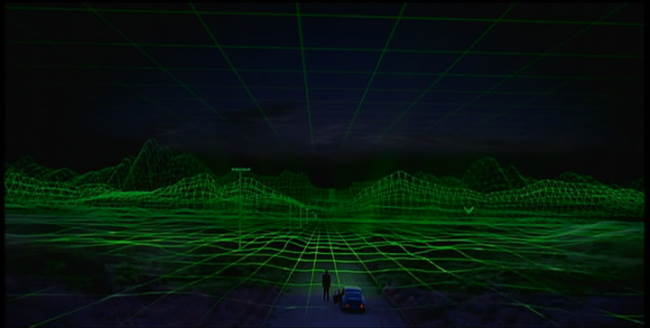
Bad fucking trip??? No…These people are real…as real as you and me.
Overview: The Thirteenth Floor is one of the truly fun virtual reality (VR) movies out that have been produced. This movie has everything from a fun film noir settings in a VR simulation, to pure mind fuck scenes, to great VR effects. The story catches you from the beginning and picks up speed as it goes. To top it off, Thirteenth Floor is loaded with style.

The Thirteenth Floor centers on a small R&D software company (located, um, on the thirteenth floor of a large building) that has created a completely realistic similated world that has lifelike VR Sims. Corporate owner and computer scientist Hannon Fuller (played by Armin Mueller-Stahl) discovers a secret so important that he’s sure someone is trying to kill him. He hides a message for his protégé, Douglas Hall (played by Craig Bierko), inside of the 1930s game simulation. After Fuller is murdered, things get truly strange. His previously unknown daughter (Gretchen Moi) comes to claim the corporation in order to shut it down, and a Detective (Dennis Heysbert) investigating the murder becomes convinced that Hall is guilty. When Hall , with the help of the lead programmer (played wonderfully by Vincent D’Onofrio), enters the “game” by taking over the consciousness of one of the game sims, he eventually learns the earth-shaking secret. Unfortunately for Hall, one of the game sims has learned it as well, and is not happy about it. At this point, the Thirteenth Floor truly takes off.
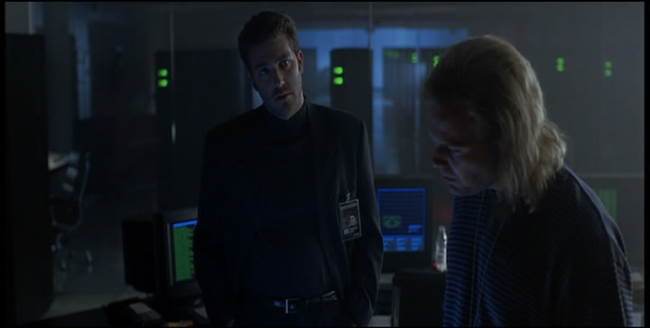
The Visuals: The Thirteenth Floor is loaded with high tech visuals in the “real” world and realistic film noir thirties visuals in the simulation. The modern visuals are sleek, with shocking neon greens, blues and reds interwoven into a dark blue-gray environment. Considering cyberpunk comes from a future-noir approach, I found the film noir add-on doubly appealing here.
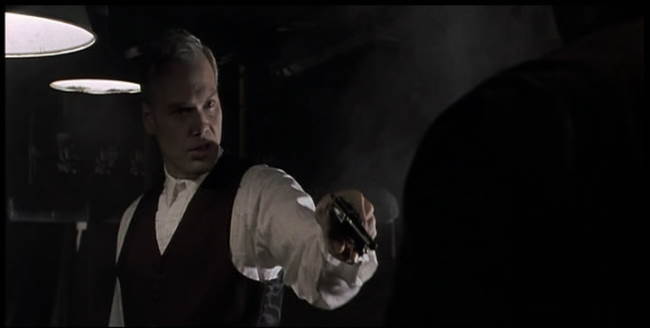
The Bottom Line: The Thirteenth Floor has a terrific cast and an interesting story that really does work for the most part. While only a few characters are given real depth, the story and effects are able to carry the show. The cinematography is truly terrific, with great use of shadows and interesting lighting contrasts. On top of this, the ending provides us with a very interesting and well done mind fuck that will stay with you for a few days. All in all, thirteenth floor also has some nice cyberpunk musings concerning the nature of reality, and whether or not we would really know if it we were actually a part of some game designer’s grand simulation.
~See movies similar to this one~
Tags: cyberpunk movie review Thirteenth Floor
Year: 1999
Directed by: David Cronenberg
Written by: David Cronenberg
IMDB Reference
Degree of Cyberpunk Visuals: Medium
Correlation to Cyberpunk Themes: High
Key Cast Members:
Allegra Geller: Jennifer Jason Leigh
Ted Pikul: Jude Law
Kiri Vinokur: Ian Holm
Gas: Willem Dafoe
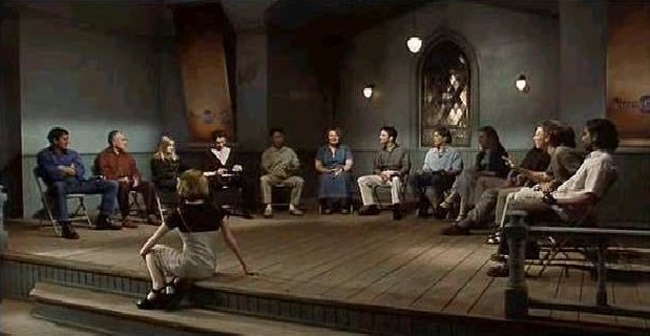
Overview: Existenz is one of the really good twist-your-brain VR game movies. ExistenZ allows us to imagine a rather strange future where games themselves potentially tear down the fabric of humanity. David Cronenberg, master of the weird, has Jennifer Jason Leigh starring as Allegra Geller, a game designer who creates VR games that are inserted directly into the spinal cord from an invasive “game pod” modification into the middle back vertebrae. Entire sets of players use living “game pods” to interact in the VR games. In this movie, Allegra is doing a “focus group test” on her latest game called eXistenZ. Everything appears fine until all hell breaks lose when one of the players gets up and tries to Kill Allegra for destroying the fabric of society.
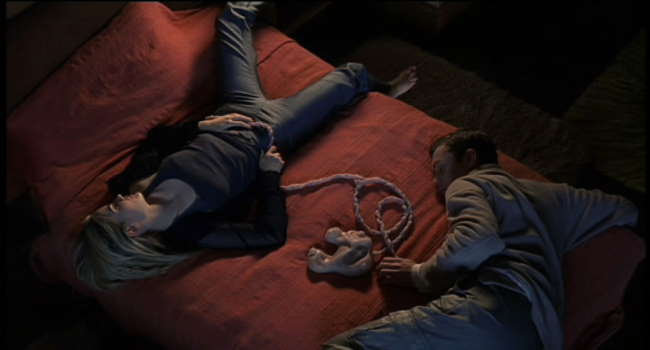
As the movie progresses, Allegra and Ted Pikul (played by Jude Law), an unsuspecting marketeer are thrown together during the escape. While on the run, Allegra talks Ted into experiencing eXistenZ. To do this, he needs to get a game pod installed in his back. Things go from bad to worse as they attempt to get a pod from a shady guy, and significantly damage Allegra’s game pod, which has the only copy of ExistenZ anywhere on it. As the movie progresses, Cronenberg makes sure the viewer never really knows if the characters are in the very real looking game, or are actually in reality.
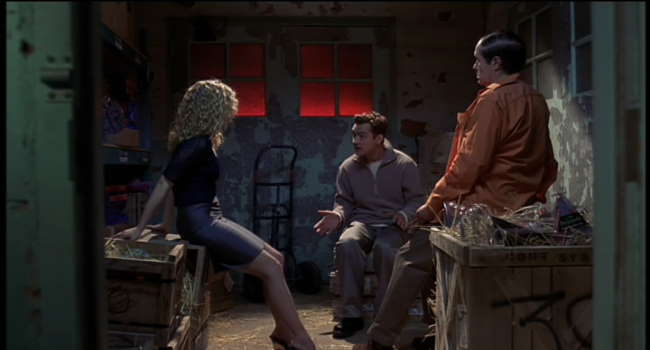
The Plot and Pacing: The plot is more than passable in eXistenZ, the action is good, and the acting is above average. Jude Law, Leigh, Ian Holm and Willem Dafoe are very solid and engaging in selling this story. The pacing gyrates from massively wierd head-spins to periods of calm and reflection. All in all, it’s enough to keep you captivated.
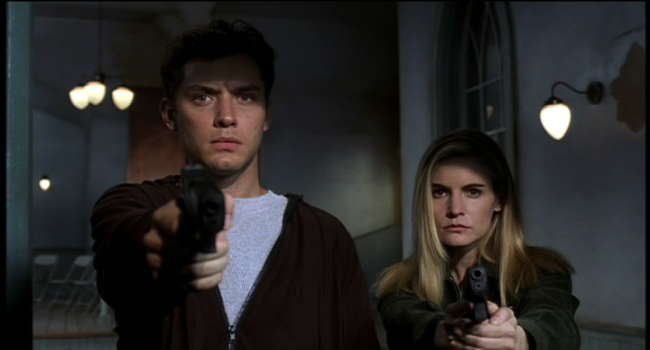
The Bottom Line: ExistenZ asks the question whether we truly know when we are in reality or not? This is interesting in that if direct VR type connections get made to the human nervous system as Kevin Warwick’s work suggests might be one day (soon) possible, this question becomes significantly more pertinent. All in all, this makes for a wonderful cyberpunk flick with some terrific scenes and interesting thoughts. With a production budget of only 15 million, the visuals are not always high tech (there are a few cool beasties though), but the story serves to aid in suspension of disbelief.
~See movies similar to this one~
Tags: cyberpunk movie review ExistenZ
Year: 1995
Directed by: Christian Duguay
Written by: Philip K. Dick (story), Dan O’Bannon & Miguel Tejada-Flores (screenplay)
IMDB Reference
Degree of Cyberpunk Visuals: Medium
Correlation to Cyberpunk Themes: Medium
Key Cast Members:
Joe Hendricksson: Peter Weller
Jessica Hanson: Jennifer Rubin
Becker: Roy Dupuis

Overview: Screamers is a low budget near future outer-space movie with some cyberpunk elements in it. We get all powerful corporations and some interesting android/robot self-replicating development. While it has some serious story issues, and doesn’t always have the best acting or FX, there’s still enough here to make it pretty interesting, especially if you’re a fan of RoboCop star, Peter Weller.

The Story: Screamers takes place in a dystopic near future (2078)e environment, where mining colonies on remote planets have been at war with the N.E.B. Corporation for the past 20 years. After a new substance that made space flight possible, called Berynium, was discovered, the N.E.B. Corporation sent out mining teams to the planet “Sirus 68” to mine the Berynium, but unfortunately, it was discovered that the Berynium was accompanied by massive does of radiation. The miners and scientists on the planey Serius 68 revolted, and soon a larger alliance was formed to fight the all-powerful N.E.B. Corporation.
N.E.B. responded by dropping nuclear bombs to kill the alliance soldiers on Serius 68, and then sent in ground troops to finish the job. The alliance responded by developing “screamers.” Screamers are small sentient robots that can burrow underground at a high rate of speed, and then come up and chop humans to mincemeat. The alliance developed a self-sustaining lab that allowed the robots to self-replicate and included learning algorithms to improve their attack capability. The alliance also included an identification beacon so that the screamers would not attack alliance soldiers. Unfortunately, the screamers have begun to learn, so much so that they have started developing their own models, and worse, have started to disregard the identification beacon.
Commander Joe Hendrickson, who has been on Serius 68 since the beginning of the conflict figures out that the war has forgotten Serius 68, and has decided to try to visit the commander of the N.E.B. forces in order to make a ceasefire. Unfortunately, as he discovers in his trek, the N.E.B. forces are the least of his concerns.
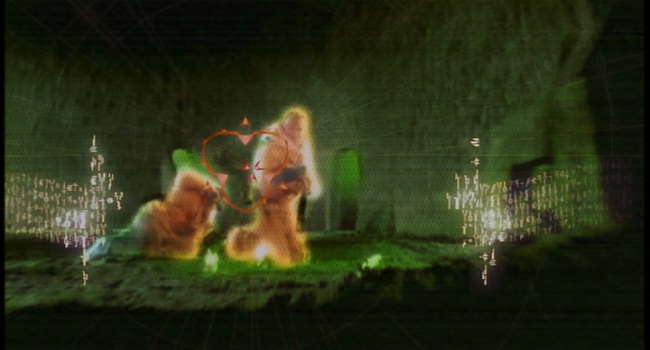
The Visuals: Screamers is a cross between Alien inside visuals and a desert-like Road-Warrior setting (without the punk stuff), or perhaps better said, a Pitch Black setting. Orange is the color du jour. In general, the look and feel of the internal set designs are far less realistic than the outside world. Some of the inside sets would look right at home on a sci-fi TV series. The creatures are pretty low budget too.
The Believability Factor: Although originally based on a Philip K. Dick short story, there are enough problems with the story here that cause you to pause. In addition to some real whoppers regarding the overall plot (for instance, if humans could build adaptive learning robots, why didn’t they just get the robots to mine the radio-active Berynium?), and some serious acting issues on the part of some of the minor characters. Still, both Peter Weller (RoboCop) and Jennifer Rubin are good enough to make this worth watching. More so, the evolution of the robots, while often “magical,” is done at least well enough to make you take pause and actually have a deep thought or two about it.
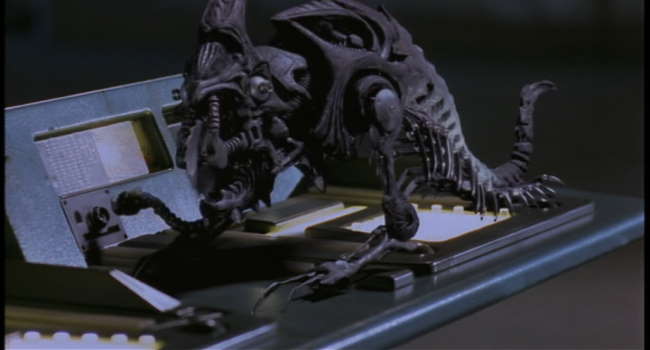
The Bottom Line: I’m really torn in deciding whether to give Screamers a 5 or a 6 star rating. This is not a great movie, but there’s just enough here to make watching it worthwhile. If you’re in to dystopic futures, especially ones involving outer space, you’ll probably want to see this. If you’re in to developing AI type movies, this also should hold interest for you. In terms of “cyberpunkness,” the same thing applies – there’s just enough here to include it as watchable cyberpunk, although you’d be find just calling this a space-sci-fi movie.
~See movies similar to this one~
Tags: cyberpunk movie review Screamers
Year: 1994
Directed by: John Murlowski
Written by: Patrick Highsmith (story), Susan Lambert & Patrick Highsmith (screenplay)
IMDB Reference
Degree of Cyberpunk Visuals: Low
Correlation to Cyberpunk Themes: Low
Key Cast Members:
- J269: Olivier Gruner
- Nora Rochester: Daphne Ashbrook
 
Overview: While some might argue that Nemesis is a better film, I actually like “B” action movie master Olivier Gruner’s performance in Automatic better. Automatic has Gruner starring as J269, a “J Series Automatic” cyborg who’s job it is to protect human life, and most importantly, employees of the RobGen corporation. During the course of his duties, he encounters a RobGen senior manager attempting to rape Ms. Nora Rochester (played by Daphne Ashbrook). In preventing the attack, he ends up accidentally killing the RobGen manager. Not only does killing a human this unlock his freewill, it causes the Goddard Marx, the founder of RobGen to try to kill him and Ms. Rochester in order to cover up the fact that an “Automatic” killed a human.
The Bottom Line: As with many low-budget derivatives, there is nothing truly new storywise here. Unfortunately, I only have a VHS tape of this, so I can’t give you screencaps, but there’s nothing new visually here either. Eventually Automatic turns into a cyborg version of Die Hard. But Gruner plays 4 separate roles pretty well; the action is good, and the FX are just believable enough to keep this interesting. And the twist at the end provides a nice solid ending.
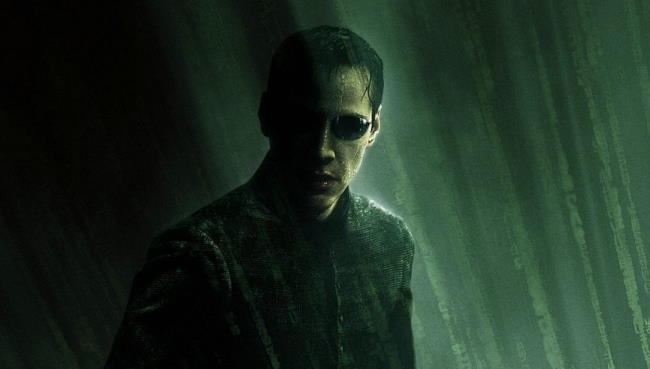
Overview: Since online debate around the Matrix Trilogy has been beaten to death, I’m guessing by now you’ve already long ago made up your mind on whether you liked or hated the Matrix and its subsequent sequels. Truly, whatever you decided is fine with me. As it turns out, I love them and generally think they’re great. And NO, I’m not really interested in having a Matrix Sucks/No You just don’t get it discussion. Please start a new thread in the Meatspace if you’re still interested in such banter. This essay is for something else - it’s about viewing the trilogy, specifically Neo, from a man-machine interface, or cybernetics perspective.
While most of the discussion around the trilogy deals with the classical philosophies expressed, very little discussion seems focused on a strictly sci-fi perspective. Why, I cannot say, but purpose here is to attempt to explain how the trilogy truly makes sense from a cybernetics perspective - a viewpoint that is just as intentional as the philosophical/religious journey. If you take the time to read this, forget about the philosophical and metaphysical stuff for a minute, and forget about any dialogue and acting issues you might have with the sequels. Instead, I want you to look at the trilogy purely as science fiction. Specifically I want to discuss Neo NOT as a messianic figure but as a Cyborg - a symbiotic combination of a sentient program and human being that evolves and integrates over the course of three movies. This essay assumes that you are familiar with all three movies, and will be filled with spoilers (I will also mention how Neo’s man-machine integration relates to the end of Ghost in the Shell).

A Word about Battery People: Battery people are those humans who were birthed and raised in the Matrix. Both the Animatrix and the first Matrix movie makes clear that the former battery-people (those people stuck in the Matrix Pods from birth but who now live in Zion) are REPLEAT with electronic parts. Their entire nervous system is wired from head to foot. They have massive amounts of electronics in their brain that allow a virtual reality simulation to completely take over all sensory and perceptual elements. But the purpose of the cybernetic implants is two-fold – it is used to allow perceptual control of the battery people (cyborgs) and its designed to harvest and transfer human-generated energy into electricity.

What is the Matrix? The Matrix is the Machine City’s power plant. It is not the focus of the machine’s existence, it is merely their source of their energy. My guess would be that most sentient machines and programs care little more about the Matrix than you do about your local electric company. Only the power plant manager – the Architect – and those working for him are truly obsessed with the running of the Matrix.
Communicating With The Machine City: Every aspect of the machine city’s society (what little we know about it) is about wireless communications. The leader sentinels (the ones with the mini-satellite dishes) appear to be almost constant communication with the “source,” and then communicates orders to the drone sentinels (who do not appear sentient). The sentinels can only “see” energy. This is the reason that the humans shut down all power when the sentinels come (this way they cannot see the ship). However, given the above discussion on battery people, it’s also clear that Sentinels can “see” battery people when they run (The end of the Matrix and Reloaded shows this). The battery person, or “cyborg’s” implants, part of whose function is to harvest human energy, gives off some kind of energy that is noticeable.
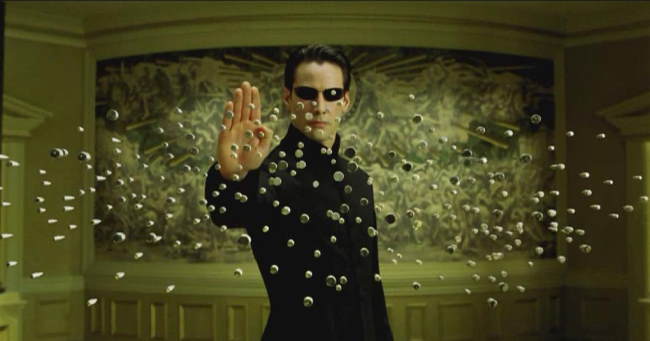
How is Neo Different From Other Battery People? Now lets get to Neo - in the Sci-fi interpretation, we find that Neo actually had a special package implanted in his head at birth that was different from the other battery people (re: the architect’s conversation). This package includes both a sentient program learns over time, and a method to communicate directly with the source. Neo the “person” is actually not just a person or even a normal “battery” person, but is a symbiotic combination of human and learning sentient program. The sentient program in a very real sense is “part” of Neo. It is not a virus living off a host – it is a fully integrated entity, which transforms Neo into a true man-machine organism just as Motoko was at the end of Ghost in the Shell. The sentient program’s communications package is necessary for the “One’s” eventual planned destiny – this is part of the architect’s control loop whereby the One returns to the source and freely agrees to let the human portion of him die, and then freely communicates the sentient AI part of him back to the source to reboot the matrix. The sentient portion of the One isn’t dead, and may eventually return to the Matrix, similar to how the sentient portion of Seraph (a former “One”) has done.
So Neo has the ability to communicate with the Source and, because of his unique purpose (to understand and update the Matrix, he has “sysadmin-like” machine city powers in a computer sense required to reboot the matrix (after all, this is his intended purpose). These two aspects – his sys-admin ability and wireless communications ability - provide that rationale for Neo’s ability to communicate/attack/destroy other machines and programs from the source both internally in the matrix and externally (wirelessly) in the real world. It’s also clear that Neo has the ability to see energy similar to the sentinels - this is different from a broadcast signal. Basically, Neo was given the same capabilities for sensory perception as the machines, and is the ONLY human that has the capability to send and receive wireless communications. Incidentally, for those matrix fans watching at home, this is why the 13th floor scenario (matrix within a matrix) makes no sense.
With this basis, the much talked about and often misunderstood scene near the end of Revolutions, where the “ghost” sentinel goes through Neo also makes sense. Neo has been attacking the sentinels and other machines wirelessly for some time. The ghost sentinel going through him is merely a return wireless attack by a foe who is changing their tactics to meet the enemy’s assault. The sentinel essentially did a ghost-hack type attack, where energy from the sentinel is sent back at Neo. And in fact, the attack was successful – so successful that it momentarily knocks out the sentient program portion of Neo, so only the human part is conscious. At this point, Neo cannot see the machines and cannot fight back, so he tells Trinity to go up above the nano-clouds that destroy all electricity and block out the sun.
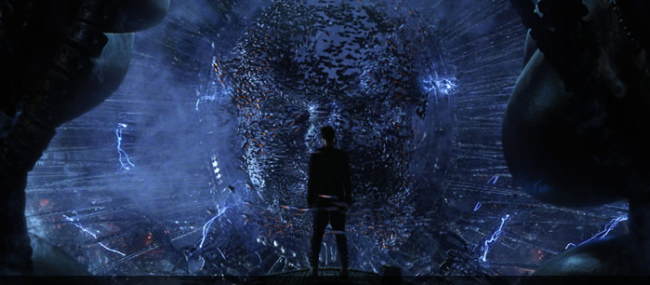
The Scifi View is Different: Again, I’m CLEARLY separating out the sci-fi view from the metaphysical/religious view here. If one takes the metaphysical view, Neo becomes self-realized, and this has nothing to do with sentient programs or all the rest - but then the “belief” in his powers has to do with more metaphysical/religious connotations. He becomes the “One” in the same way Buddha or Jesus did - through his path to self realization. This is a significantly different but parallel storyline. Both the religious view and the sci-fi storylines are significantly different, but just as intentional. To reiterate - the matrix trilogy is fully allegorical in the sense that the entire trilogy was INTENDED to be viewed from separate and distinct story lines. This also addresses one of the many knocks on the trilogy – many knock many of the key scenes as incoherent or vague. This was purposeful action on the part of the Wachowskis. Most of the key scenes are “specifically” vague just so that they can be properly interpreted in two completely separate storylines. More than anything else, this truly is the magnificence of the story line across all three movies.
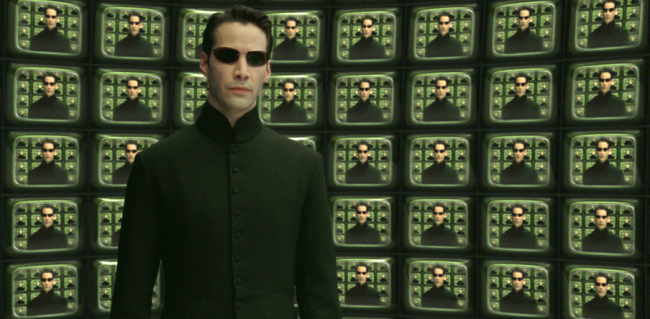
Recap and Explanation: To reiterate, all battery-people are FULLY embedded with cyborg components that can completely take over full perceptual control - this was made abundantly clear in the first movie. The cyborg components run completely throughout their nervous system - only the outside pieces are ever removed. If you view the trilogy with these points in mind, here are some actual plot points to reconsider:
- The sentient program in Neo first “turns on” and temporarily “takes over” the body “Neo” when the human portion of him dies in the first Matrix movie (M1).
- This explains why the agents want to kill Neo in M1, even though he’s the key to the architect’s control system (another question often asked). To meet the Architect’s needs, the sentient program portion of Neo has to fully engage and this only happens with the death of the host. The Oracle knew this, which is why she “predicted” this.
- The integration proceeds throughout Matrix Reloaded (M2) - this is how Neo “sees” the matrix green and now “yellow” energy of the machine city code. Some say the cookies and candy provided by the Oracle helped with the symbiosis process (others say this was her way of subverting the Architect’s intent).
- The architect states that Neo needs to freely provide this code back to the machine city (which communicates though wireless communications) in order to reboot the matrix. This explains both the wireless capability and the need for the sentient program, which is a product from the machine city, to have the same sensory perception as other things from the machine city.
- The purpose of the sentient program is to fully understand current human thought process and the nature of their evolved perception so that it can reboot the Matrix effectively to return the negative feedback control system (that’s a cybernetic term, not meaning “bad” feedback”) back to its initial goal state. This explains the rationale for the sys-admin-like powers.
- Combining the wireless capability and machine city sysadmin-like powers, the sentient program portion of Neo now has the ability to “attack” machines outside of the matrix.The CLEAR sign of this was near the end of Revolutions, when the machine “ghost” launched an attack back at Neo as he approached the Machine city. The wireless portion of Neo was knocked out, so Neo, now dazed, was no longer able to either see or hurt the machines - in a reverse from his death in M1, now on the human portion of Neo was operating alone.
- This also explains how Mr. Smith was able to get powers outside of the Matrix. Because he mixed with Neo’s essence, in fact what happened is Mr. Smith obtained a portion of Neo’s sentient program which mixed with the Agent, creating something altogether new and deformed. (which is why Mr. Smith is orange in Matrix colors versus something yellow or green). Mr Smith as a sentient program invaded a battery-person who still had all the implants that any battery person does, but Mr. Smith could not attack Neo wirelessly, as he didn’t have the extra hardware needed.
- Seraph also provides support for this understanding. He is a former “One”. The sentient program portion of him is all that exists now, and came back from machine city through the train station - which is why he was an indentured servant for the Merovingian. As an aside, Seraph also provides clarity to the intended religious portion of the story arc – Neo will arise again, but only the sentient program portion of Neo will remain.
- I will probably write a separate essay on this, but just to be clear, this viewpoint shows that the Matrix trilogy is the philosophical sequel to Ghost in the Shell (GITS). GITS2: Innocence does not follow Motoko’s journey after she integrates – Neo does. GITS2: Innocence is really a furthering of the philosophies that Oshii advanced in Avalon, meaning that conceptually, GITS2: Innocence is the sequel to Avalon, not the original GITS.

In Closing: The purpose of this essay was to show that the Matrix Trilogy does indeed make sense from a purely sci-fi perspective. No religious conversations necessary here – I’m not expecting you to magically love the sequels now even if you understand and accept my reasoning – I’m just providing you some points for you to consider. Feel free to reject them or call me a loon. But if you find yourself re-watching these movies, try this viewpoint on and see how it fits.
This post has been filed under Essays by SFAM.
Year: 1995
Directed by: Mikio Hirota
Written by: Mikio Hirota
Degree of Cyberpunk Visuals: Low
Correlation to Cyberpunk Themes: Low
Key Cast Members:
The Terminatrix: Kei Mizutani

Overview: In pursuit of me desire to see all cyberpunk-like films out, I was seduced into getting this flick. Terminatrix is basically the original terminator movie remade with in naked Japanese chicks. In Terminatrix’s vision of the future, an evil artificial intelligence has taken over the human race, and sex is fully regulated to stop overpopulation. But one woman, seeing the injustice in this system, rebels (This is the John Conner stand-in) and starts the resistance by convincing everyone to have massive orgies of their own free choosing. To stop this, the AI sends a hot Japanese cyborg chick - the Terminatrix, played by Japanese Exploitation Queen Kei Mizutani, back in time to have find the father of the chick who leads the orgy resistance. The Terminatrix has the ability to make people impotent by fucking them and breaking their dicks off (this also seems to kill them as well). To find our future heroine’s father, the Terminatrix doesn’t know his middle name, so, um, she goes through the phone book in order to kill the male Sarah Conner stand-in. In an attempt to stop this foul plot, the resistance is able to send a single hot naked human chick (Reece’s replacement - I must say, she looks a lot better than Reece!) is sent back to stop her and to save the father (Sarah Conner substitute). Our Reece substitute can tell who Terminatrix is by checking out her ass, so she is forced to go around lifting up all the women’s skirts!
Yes, this plot is as cheesy as they come, but let me be clear about this - Terminatrix is a frickin RIOT!!! Why, you ask? On an extremely twisted level, Terminatrix so closely follows the Terminator story that you’re continually busting out in laughter. On top of this, both the writing and production values are far above what you’d normally expect from a movie such as this. Literally, if you’re as familiar with that movie as I am, and have a soft spot for over-the-top cheesefests, you will LOVE this movie.
The terminatrix’s cyborg vision lines are a riot. When having sex (they don’t get explicit here, just frontal nudity) with her victems, the Terminatrix’s “terminator screen” messages show things like, “Not cuming fast enough” or “Whip him.”. When the Reece chick finds the future father, she says, “The future of humanity depends on your penis!” At least he has the good sense to shut the door on her. Also, if Terminatrix’s future prognostication is any guide, the future is tailor-made for male chauvinists. In this “dystopia,” a computer calls you to have sex with random chicks - but here’s the bad part - you have to lay down while they to all the work! Hmm…come to think of it, I can probably imagine worse computer-dominated future scenarios than the one that prompted the revolution.
Funniest scene Hands down, the bathroom cyborg self-repair scene is a riot! You know the one I’m talking about - where Arnold has to fix up his face and stuff? In this version, the Terminatrix has been shot six times in her primary weapon (her vagina), and has to repair it. While rolling her eyes, she forces six bullets to come out of her vagina (they don’t show this other than by the dropping of bullets), then she recharges herself by putting electricity through her nipples. To make final repairs, she fixes herself down below by sitting on a mechanical dildo! In watching this, all you can say is “My God, what a bizarre flick!”
It Matters Where you Purchase This: IMDB doesn’t even have a listing for Terminatrix, so one would think its not easy to come by. At the time of this review, you can purchase it for $27 bucks at Amazon. While funny, $27 bucks is about least $18-20 more than you would want to pay for something like this. But you’re in luck as Deepdvddiscount has it for $5.99! That’s about as large a jump as I’ve seen in available DVD prices.
The Bottom Line Again, I’m rather shocked that Terminatrix has relatively decent production values. The acting isn’t bad either, so much so that it’s like they made a serious attempt at this! I didn’t attempt the dubbing track (I almost never do), but I’m guessing it’s something to stear away from. All in all, Terminatrix is a very fun entry into the cyberpunk (facade) soft-core porn market. And while this clearly isn’t cyberpunk, it is definitely a cyberpunk parody (of the Terminator). Fair warning - this movie will make you laugh out loud - it will not get you in the “mood.”
And my apologies for the lack of screencaps. I honestly tried to take screencaps but it was a waste of time, as all the cool scenes had nudity in them.
~See movies similar to this one~
Tags: cyberpunk movie review Terminatrix
Year: 2000
Directed by: Mark Neale
Written by: Mark Neale
IMDB Reference
Degree of Cyberpunk Visuals: Very Low
Correlation to Cyberpunk Themes: Low

Overview: I notice the decent IMDB rating for No Maps, but honestly, I just don’t see it. I have hard time coming up with something positive to say as No Maps for These Territories as a documentary on Gibson fails in virtually all aspects possible. You have to look long and hard to find a documentary with this little attention to detail across the board. No Maps has horrible lighting, haphazard editing and “FX” choices which detract even more from the mess that’s already on screen. In short, this film seems to be sending the message that William Gibson is a meandering scatterbrain who occasionally comes up with an interesting idea or two, but who, for reasons not of his own making, was able to become wildly popular. None of this is true of course, which is why this documentary resonates so badly with me.
Because I also gave New Rose Hotel a horrible rating, I want to be VERY clear about something – I think William Gibson is one of the most influential writers of the later part of the 20th century. His stuff is better than great. In no way does my knocking these movies reflect at all on my opinion of his literary works or his legacy. Nor do I believe that Gibson’s works cannot be very successfully transferred on-screen. Unfortunately, Gibson has yet to find his Peter Jackson.
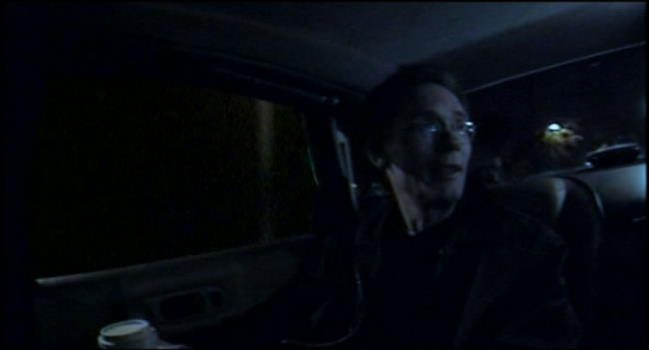
I’m guessing the cup is a prop to get more light into the picture…
The Setting: A significant part of my dislike for No Maps is based on the decision to use a car as the setting. In thinking about it, it’s really hard to imagine a worse way to conduct a documentary. The entire thing takes place with Mark Neale, the director, driving a car while talking to Gibson, who is in the back seat surrounded by a few of set cameras. In using this approach, Neale was able to generate the worst of all scenarios:
- Neale has to focus on driving so he has absolutely NO control over the cameras. This continually leads to horribly over or under-exposed shots of Gibson, grainy, and out of focus film and horrible positioning.
- Because Neale has to concentrate on driving, whatever skills he might have had as an interviewer are compromised by the fact that he’s in massive multitasking mode – he’s driving and continually checking the recording while attempting conducting an interview. My guess is after a while, Neale just wanted to make sure Gibson was talking, and stopped bothering listening to what was being said.
- Every now and then, Gibson would utter a terrific insight, such as when he mentioned that the internet all but ensured the end of the nation state. This would have been a great time for a prompting follow-up from an astute interviewer, but unfortunately, we get absolutely NO follow-up on this and many similar fascinating comments.
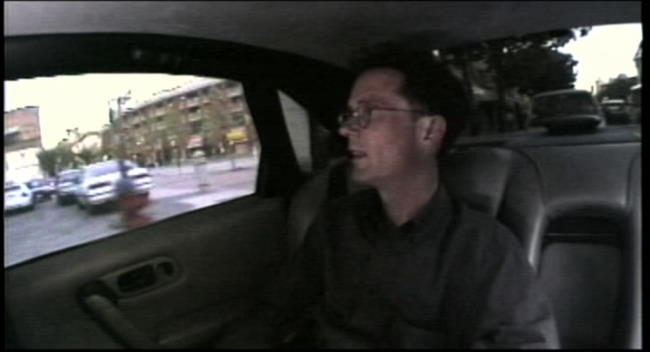
Notice that the left window scene doesn’t match with the rear window - this was intentional.
What the Cinematography Conveyed: Probably the most dissapointing aspect of No Maps relates to the unintentional visual symbols the “road trip” documentary provided. Gibson is known as a trailblazer – a thought leader in setting the course for science fiction, yet the interview in the back of the car makes him seem like someone happy to follow along someone else’s path. The title, “No Maps for These Territories ” is supposed to convey that Gibson went into un-chartered waters, yet everything in this documentary, from the meandering and repetitive music to the monotonous car ride, makes Gibson come across as someone who basically just intellectually wanders around and hopes he happens upon something interesting. In short – there was a map of the territory – it was in Gibson’s mind. This film works hard to obfuscates that fact:
- The constant penchant to splice in absolutely random images in rapid succession whenever Gibson philosophizes tends to make Gibson’s message come off as incoherent.
- The repetitive music consistenty has this meandering quality, which again, reinforces the message that Gibson wanders around through life and occaisionally gets lucky.
- The “special effects” where Neale haphazardly transferred separate drive-by the images onto the side and rear window and back side of the car so that what was coming through rear window no longer matched the side window (see image directly above for an example) served NO PURPOSE AT ALL other than to distract the viewer from Gibson’s oratory.
- The complete inattention to lighting or setting makes the entire project comparable to a neighbor’s home movie. It’s almost as if Neale was consciously trying to make Gibson (and Sterling) look as shabby as possible with the hopes that it made them more “edgy” or “real.” If this was the intent, my apologies for missing how this was helpful.

No, I didn’t have to look hard to find quality lighting shots like this one.
Perhaps the goal was either to break up the monotony of staring at Gibson in a back seat of a car for 88 minutes, or maybe it was done with the hope of making Gibson’s oratory seem non-linear, but what seems to be conveyed is that Gibson’s ideas aren’t really connected in any real way. In line with this, Gibson as the “meanderer” is re-enforced by poor editing decisions. While a few segments such as the internet one seem to have a nice flow, most segments are all over the non-existent map. What Neale unintentionally seems to convey is that if you keep a camera on Gibson long enough, like the rest of us, he’ll eventually come up with a a number of half-formed, off-the-cuff comments that go absolutely nowhere.
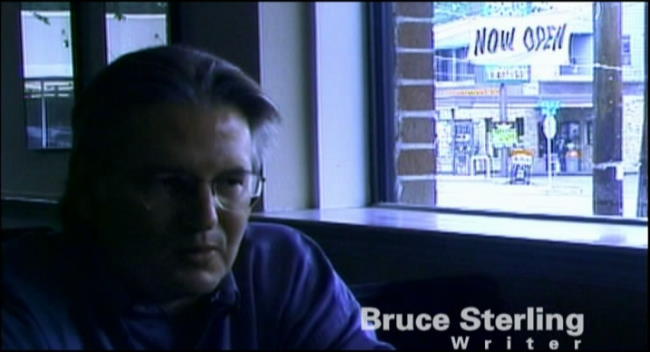
Was this shot intentional? Does Mr. Sterling own a gas station and like Marlboros? If so, probably they should have worked the camera better, as often only half of the gas station is showing.
Neuromancer’s Legacy: One thing we do learn from No Maps is that Gibson, like many great innovators, is probably the worst person to talk about his place in history, and in particular, the relevance of his earlier works like Neuromancer. When it comes to discussing his legacy, Gibson is extremely modest. He’s also a perfectionist when it comes to evaluating his prose. As he gets older, he negatively judges his earlier and discounts their value and overall importance. In discussing Neuromancer, Gibson calls it a simplistic book – as simplistic as cheesy three-chord progression songs in Album Oriented Rock music in fact, and that only teenage Goths should ever find it appealing. Never mind that it won all possible scifi awards (Hugo Award, Philip K. Dick Memorial Award, Nebula Award, Seiun Award, and Ditmar Award) and defined a whole new genre of science fiction, or that it changed the vocabulary and concepts the world over (the concept of cyberspace, for instance), Gibson still considers it pretty sophomoric. This leads to the clear implication that those who see something more in Neuromancer, or any of his 80s works, are also of the intellectual caliber of teenage Goths. Yet, in his five minute interview at a cheesy restaurant (also with shitty lighting), Bruce Sterling is able to provide more context on Neuromancer’s place in history than Gibson does for the rest of the film. Sterling points out clearly that while Gibson as an older man looking back at his life may have the right to criticize himself, but this doesn’t change the fact that he was a damn good writer back then who transformed the face of science fiction – I only wish there was an interviewer in this capable of pinning Gibson down on this. While Gibson may or may not like the prose, the ideas proposed clearly had intrinsic worth, and every so often, even Gibson acknowledges this.

This shot, which we see quite frequently in No Maps, perfectly sums up the documentary.
The Bottom Line: On the whole, this documentary performed a disservice to Gibson and his legacy. Those who have never been exposed to Gibson will watch this and conclude that Gibson was a lucky bystander in history who seemed to be at the right place at the right time. If you’re already a Gibson fan, you may get a bunch of interesting and honest tidbits from his past, but little else will be gained. In watching No Maps, I really found myself wishing that Neale had just gotten a semi-decent interviewer to sit down with Gibson in a quiet setting and interview him. Also, far more time should have been given to Gibson’s contemporaries, who clearly have a better sense of Gibson’s significants than he does. Had Neale taken this approach (one might call this a traditional documentary approach for lack of a better description), the result would have been FAR superior to the mess that this documentary produced. Again, the problem wasn’t that No Maps was produced on a shoestring budget, the problems arose from the choices made (using a moving car as the setting, where the director/interviewer/cameraman/driver was one in the same person, and the subsequent editing decisions). Yes, the name of the documentary is VERY cool, but very little else should be saved. Gibson deserves better. If history is kind, No Maps will be forgotten, and at some point, a quality documentary will be made that highlights Gibson’s most impressive legacy.
~See movies similar to this one~
Tags: cyberpunk movie review Gibson Territory Maps
Year: 2004
Directed by: Jeff Renfroe & Marteinn Thorsson
Written by: Jeff Renfroe & Marteinn Thorsson
IMDB Reference
Degree of Cyberpunk Visuals: Medium
Correlation to Cyberpunk Themes: Very High
Key Cast Members:
Simon J.: Jeremy Sisto
Derrick: Udo Kier
Howard: Lance Henriksen
Trish: Deborah Kara Unger
The Neighbour: Bruce Payne
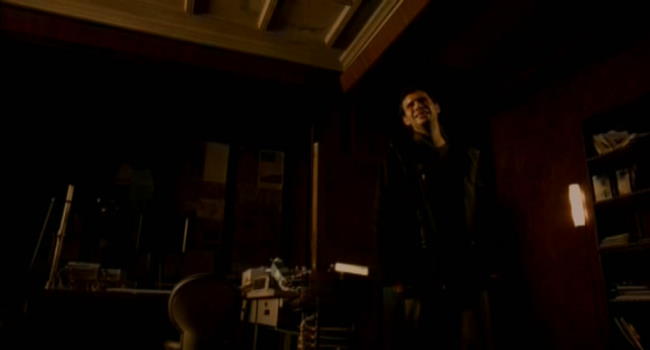
There are good people and there are bad people and they’re on their way,
and they want you, Simon…
The bad people can save you, but they won’t…
The good people want to save you but they can’t…
Overview: Every now and then I run across an absolutely extraordinary cyberpunk film, largely forgotten or ignored by the film going masses. More often than not, this film is foreign and never had a decent release in the US (where I’m from). One Point O (called Paranoia 1.0 in the US) is European a film that meets these criteria. Truly, you’ll be hard pressed to come close to finding an immersive film as One Point O. When you consider this was reportedly shot and produced on a budget of 1.7 Million, you begin to understand the enormity of what was accomplished here. No, you don’t get cool explosions or guns, or fancy CG effects, but you do get an absolutely awesome near-future dystopic story with a biting commentary on advertising and software development, all wrapped up in an extremely immersive, slow paced film. Everything is subordinated to the mood here, which is emphasized by the color choices and simple score. Unfortunately, I will need to be pretty vague in this review, as the ending definitely has a Sixth Sense type feel to it.

One Point O is about a computer programmer named Simon who works at home in a truly dingy, run down apartment building in a very shabby part of the city. He comes home to find a package waiting inside his apartment, and gets worried as nobody should be able to get inside. He opens the package, only to find that it was an empty box. This happens again and again, each time making Simon more and more paranoid. One top of this, he is late in delivering his the code he’s been working on to his customer. It appears as if his code has become infected with a virus, and worse, he really has a craving for milk!
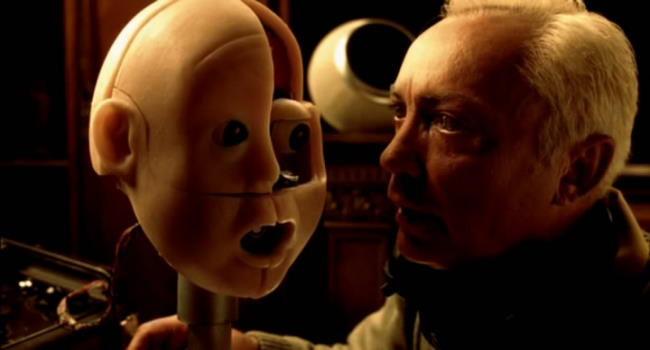
Every character in One Point O is quirky and memorable. Udo Kier (Ralfi from Johnny Mnemonic), one of my favorite role actors, plays an eccentric robotics hobbyist who has a nanotechnology-enabled couch that changes colors and cleans itself at the click of a button, and creates a sentient talking head in his spare time (this talking head named Alex has a penchant for making very prescient phone calls). Bruce Payne (Passenger 57, Hellborn) plays a neighbor VR game maker who creates S&M VR porn experiences by acting out the scenes with various partners. Deborah Kara Unger (Fear X) plays a cancer nurse in search of fleeting humanity wherever she can find it. Lance Henriksen (Bishop in Aliens) plays a strange, zen-like repairman who always seems to know what’s going on. Finally, Emil Hostina places a voyeuristic landlord who loves to eat meat. But its Jeremy Sisto who steals the camera - he’s simply terrific playing a normal guy overtaken by extremely weird events.

The Visuals: Like many cyberpunk movies, One Point O is dominated by a single color scheme - in this case we get a spectrum, from a yellow to pale orange to reddish-brown, with an occasional pale green as a highlight. Pretty much the whole movie (with the exception of the white convenience store which represents the corporation) takes place in those colors. Further accenting the dystopic quality is the continually run-down feel of the place. The apartment building is continually falling apart, as is virtually everything else except for the local drug store. While its clear that advanced technologies are the norm in this world, the people in One Point O have clearly been marginalized. They play with patchwork toys and out of date technology.
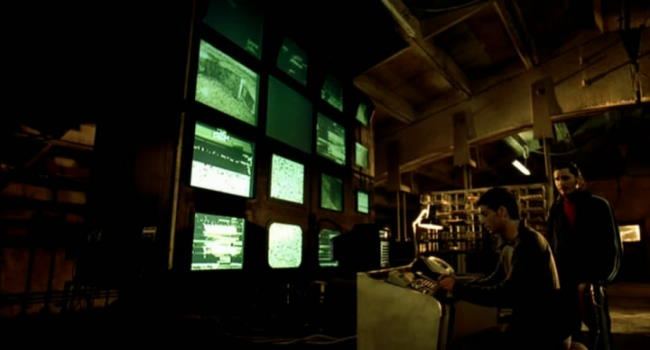
The cinematography is consistently interesting in One Point O, with many using floor shots with expansive backgrounds. However, in some cases, they probably go a bit over-board on the camera angles, such as the use of the close-up phone shot of old, which actually took attention away from the story telling. But again, this is a minor gripe, especially when we include the editing, which for the most part, is also outstanding. But in watching the deleted scenes, I do agree with the director’s commentary that a few shots probably should have been included, most notably the throw-up scene.

The Message: While I can’t go into the actual plot for fear of ruining the experience, I will say that One Point O has perhaps the most biting commentary on advertising and software development you will find anywhere. There is no question who is evil in this movie, even if they are rarely seen. Renfroe and Thorsson take to extremes and then crystallize problems they see in today’s world that form the basis for the story in One Point O. But they don’t state it in an in-your-face way - far to the contrary in fact. The story itself hammers home the message in the starkest manner possible.
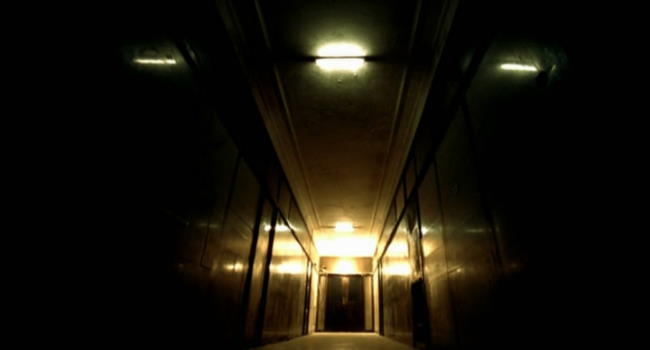
The Bottom Line: As long as you’re not looking for action or sleak visuals, but instead are looking for original cyberpunk themes done wonderfully well on a shoestring budget, One Point O is for you. One Point O is definitely a movie I would LOVE to talk about in detail but I cannot for fear of spoiling the terrific ending (maybe creating a spoiler thread in the meatspace would be the way to discuss it). The pacing has a slightly repetitive feel to it, but only because the movie progresses in a spiral pattern - the same basic pattern of events happen each pass, but events spin further and further out of control each time around. But again - go buy this movie (you’ll want to watch it more than once) - you won’t be disappointed.
~See movies similar to this one~
Tags: cyberpunk movie review paranoia
Year: 1993
Directed by: Albert Pyun
Written by: Rebecca Charles
IMDB Reference
Degree of Cyberpunk Visuals: Medium
Correlation to Cyberpunk Themes: Medium
Key Cast Members:
- Alex: Olivier Gruner
- Farnsworth: Tim Thomerson
- Angie-Liv: Cary-Hiroyuki Tagawa

~86.5% is still human~
Overview: Surprise surprise - another movie with Gruner playing a cyborg - this time by Martial Arts cyborg master, Albert Pyun. Like Gruner’s performance in Automatic (1994), Nemesis is also a decent “B” cyberpunk flick. In Nemesis, Gruner does his Robocop impersonation while trying to fight bad guys in the year 2027. In a well done style over substance movie, we get a nice underground war between cyborgs and humans. Throw in a good bit of Escape from New York and Blade Runner knock-off visuals and you have yourself an evening of trashy fun! Again, nothing new here, but the action is actually done well enough that you might want to give it a watch if you’re hankerin for mindless but fun Robocop knockoffs.
The forums are up now and are linked in the Navigation bar. Access and post to the Virtual Meatspace to your hearts content! This is a great place to ask about movies I haven’t yet put reviews up. I have at least 40+ more to go, and have generally left the popular ones like the Matrix movies and so forth out so far. Chances are you all have seen those and have already made up your minds, so I’ve been concentrating mostly on more obscure ones (not all are obscure, obviously).
Also, again, I am looking for other reviewers, especially for other types of cyberpunk media. I would LOVE it if one of you cyberpunk book experts would agree to do something similar for the book world, or the Manga/graphic novel folks, or the art types, etc.
In other news, I’ve moved the site development posts to the right side under Other Blog entries.
This post has been filed under Site Development by SFAM.
WordPress database error: [You have an error in your SQL syntax; check the manual that corresponds to your MySQL server version for the right syntax to use near '' at line 1]
SELECT COUNT(ID) FROM
|








































